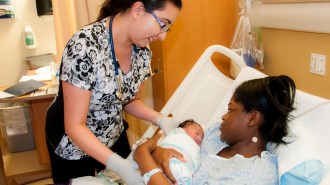From the July 22, 1933, issue

PERKINS OBSERVATORY 69-INCH MIRROR IS THIRD LARGEST
Third largest in the world and the first all-American giant telescope, the 69-inch telescope of Perkins Observatory of Ohio Wesleyan University is now in operation.
When its mirror was being placed in position just after being coated with silver, the unusual photograph on this weeks cover was taken. Where star images are captured when the mirror is in its mounting, there may be seen reflected a portion of the graduated circles of the telescopes mounting.
Dr. Harlan T. Stetson is director of Perkins Observatory.
The mirror is the first large telescope disc to be made in America. It was cast of high-quality borosilicate optical glass at the U.S. Bureau of Standards at Washington and it was ground, figured, and polished at the factory of J.W. Fecker Company, Pittsburgh, Pa. Warner and Swasey Company of Cleveland made the mounting.
FIND EGGS THAT WERE FRESH A MILLION YEARS AGO
Eggs laid by giant ostriches in drifting desert sands approximately a million years ago are being discovered in several regions of China. Eggs or fragments of eggs have been found at 21 localities, representing perhaps as many nesting areas of the fossil birds. The fossil eggs are of gigantic size, the largest being a little more than 6 inches long, or nearly 1 inches greater in their long diameter and 3 inches greater in girth than those laid by the ostrich of the present day. Not only are these fossil eggs much larger than any laid by the living species, but they also had much thicker shells, those laid by the early species in the oldest strata having been found to have a thickness as great as 2.7 millimeters–that is, a little less than one-eighth of an inch. It would certainly have taken some nerve on the part of the egg epicurean of that day to crack the shell of that egg on his breakfast table.
CANCER SUSCEPTIBILITY DEPENDS ON SINGLE GENE
Just one gene in the germ cells from which you grew–an almost infinitesimal thing about the size of one molecule–determined whether or not you are susceptible to cancer.
For it is that tiny, single unit among the many complex factors of heredity that makes the difference between cancer susceptibility and cancer insusceptibility, Maud Slye of the Sprague Memorial Institute and the University of Chicago has found.
The scientific research from which Miss Slye draws this conclusion is reported in the American Journal of Cancer. Her studies on cancer inheritance have been carried on for 23 years and involve over 116,000 autopsies.







